
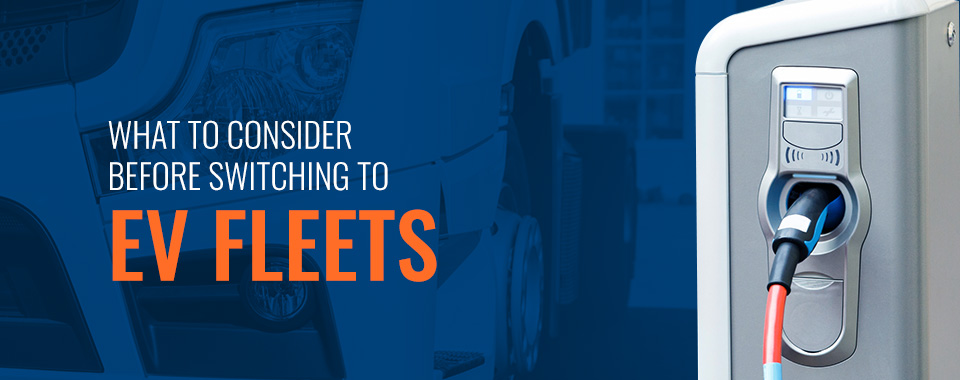
Whether you run a national courier company or a small local delivery fleet of cargo vans, transitioning to an electric vehicle fleet makes good financial and environmental sense. However, switching your delivery or service vehicles over to electric ones takes a fair amount of planning. There are many factors to consider when switching to an EV fleet, from financial budgeting to route planning to implementing EV fleet vehicle tracking.
This guide provides helpful information on what to consider when switching to an EV fleet. We’ll also cover some of the important reasons why companies are making the switch, as well as how you can leverage fleet vehicle tracking technology to streamline your transition.
When transitioning to an EV fleet, many of the considerations will apply broadly to every business. However, it’s also important to consider your fleet’s unique needs and how to tailor your transition strategy to your business specifically. Considerations such as how many vehicles you have, the distance you travel and the amount of urban and suburban driving you do on average will all vary between organizations.
Here are some of the top things to consider during your EV fleet transition.
The first thing for any business to do before switching to an EV fleet is to ensure it makes financial sense. Upgrading to EV vehicles can be a massive expense, so it’s important to ensure your business will see the returns that make the investment worth it. The best way to calculate the financial viability of the upgrade is to compare the total cost of ownership (TCO) between conventional and electric fleet vehicles.
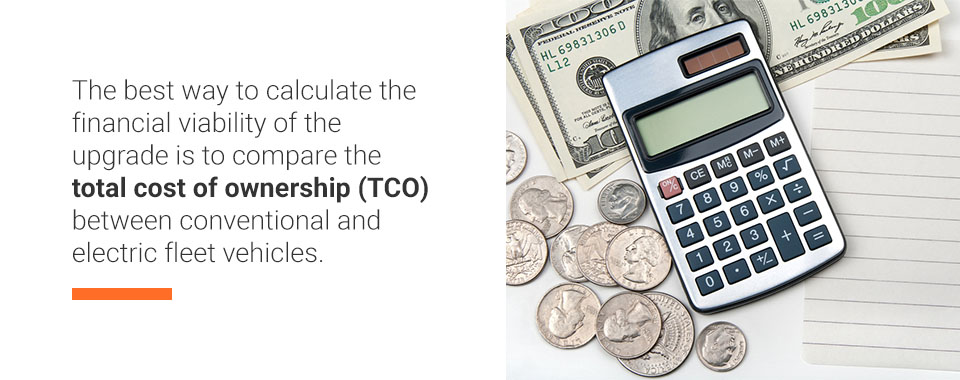
At this point, the purchase price of electric vehicles is higher than comparable traditional vehicles. However, the total cost involved in owning and operating an electric vehicle may be lower. In addition to comparing purchase prices, it’s important to factor in the necessary fuel and maintenance costs involved in a traditional fleet that will be significantly lower in an electric fleet. These immediate savings free up working capital to reinvest into the business, including hiring more drivers. It’s also important to consider any tax savings and incentives that will reduce the TCO on EVs.
Switching to a fleet of electric vehicles requires managers to consider the average and total driving distances a fleet vehicle undergoes daily, monthly or annually. It’s important to determine your fleet’s maximum drive distance to know how much mileage you can expect to put on your new EVs. Consider whether your drive distances fluctuate throughout the year and whether or not you plan to expand into new markets in the next 8-10 years, which is the typical lifespan of a fleet vehicle.
In addition to knowing the maximum drive distance of a fleet vehicle, it’s also important to consider the average short, mid and long-range distances that each vehicle is expected to drive. The term charge anxiety refers to an electric vehicle owner’s continued apprehension about whether or not they’ll be able to complete their drive before having an opportunity to recharge. Knowing your typical drive distance can help you plan your fleet needs accordingly and mitigate charge anxiety. Finding an electric vehicle that can cover more distance on a single charge can also help alleviate this concern.
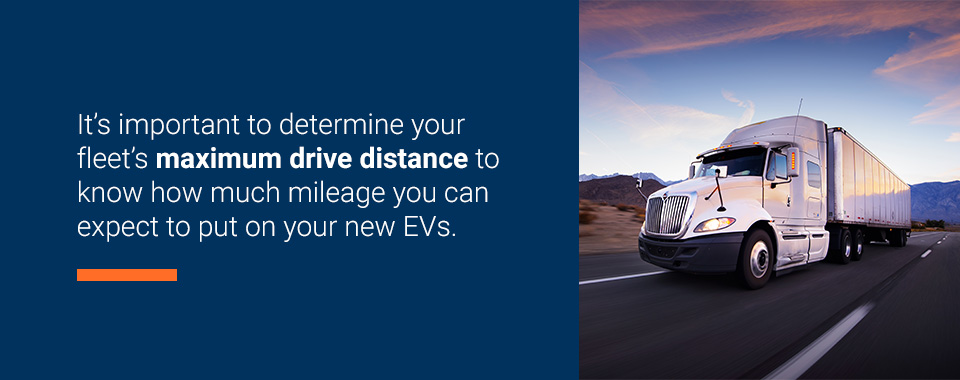
A successful EV fleet transition is all about knowing your fleet’s driving habits. It’s not enough to know your fleet’s maximum and average drive distance to ensure effective route planning that accounts for recharging. Fleet managers also need to have keen insight into driving behavior that can affect EVs more so than traditional vehicles. To ensure that your EVs are always charged whenever you need them, you must know about typical idling habits occurring during an average trip.
How long your vehicles tend to spend idling will determine how many and what type of charging stations you need and how to plan routes accordingly. Consider that idle time may fluctuate throughout the year according to weather. Every fleet will have different idle time behavior depending on the location, the population of the city, the typical daily congestion and the type of services you provide. Always use your own truck tracking data to help make an informed calculation.
Once you have a firm idea of your EV fleet driving distances and habits, you’ll be better prepared to implement an intelligent charging strategy. Adequate charging infrastructure and planning ensures your drivers have a fully charged vehicle or access to a nearby charging station as needed. Electric vehicle fleets have three different charging options for types of equipment, using different amounts of power. How fast of a charge each option provides is their main differentiator.
Below are your three electric vehicle supply equipment (EVSE) options to consider in EV fleet planning:
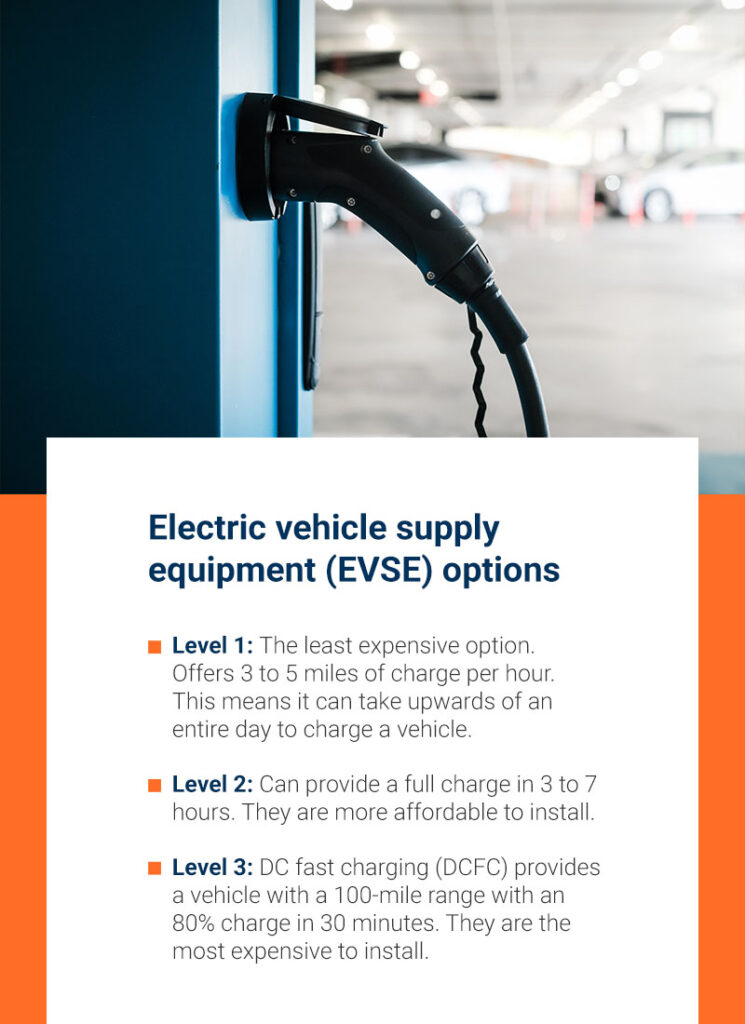
In addition to knowing the type of EVSE you need to incorporate into your EV fleet plan, you also need to know the number of stations. This number will depend on the number of vehicles in your fleet, their duty cycles and their maximum range.
Now that you know which type of charging stations you’ll incorporate into your EV fleet management plan and how many of each you’ll need, the next step is to determine where you’ll install your EVSEs. For a comparably short average daily driving distance per vehicle, your best bet is to have your charging station installed at your depot. If drivers use their vehicles for personal use as well, then setting up a charging station at their homes is also an option.
As part of your fleet management route planning approach, you may also need to provide drivers with an approved list of public EVSEs locations available throughout their route that they can use in emergency situations. Regardless of your approach to installing EVSEs, it’s important to consult with an electrician or electrical engineer to ensure that your current electrical infrastructure can either withstand or be upgraded to the necessary charging equipment.
There are plenty of secondary considerations to look at when switching your fleet to electric vehicles. Some of the secondary factors come from government authorities, which continue to regulate and incentivize the conversion to electric vehicles among both consumer and business markets.
Financial incentives exist at both the state and federal levels to promote the adoption of electric vehicles. With the exception of GM and Tesla products, the $7,500 federal tax credit applies to the purchase of all new EVS, regardless of any additional incentives offered by the state. Despite the credits that help encourage electrical vehicle adoption, some new regulations apply strictly to electric vehicles. According to the National Conference of State Legislatures, 30 states require that electric vehicle owners pay an annual registration fee, ranging from $50 to more than $200 per year, depending on the state.

A final factor for managers to consider when switching to an EV fleet is the data collection required for a smooth transition. Fleet telematics and GPS tracking must play a key role in the transition from traditional fleet vehicles to EVs. The ability to track and record driving distances, usage and energy consumption can help managers better develop their deployment strategies, plan delivery and service routes and maintain greater financial control over their fleet.
Collecting drive-cycle data removes the guesswork out of managing an EV fleet. Telematics and GPS tracking help managers alleviate some of the common challenges associated with managing electric vehicles. By knowing how frequently EV vehicles need to be recharged based on the amount of driving distance, managers can plan accordingly as to when vehicles will need to undergo full charging and when. The data provided by telematics systems and tracking gives managers clear insight to make these informed plans.
Knowing what’s involved in switching to an EV fleet is only part of the equation. The other part is getting clear on your company’s reasons for making the transition. As a business, it’s important to understand your company’s goals and how upgrading to an EV fleet aligns with this overall vision. Perhaps the goal is to increase operating efficiencies or provide drivers with a better experience. Maybe it’s part of a branding evolution, focusing more on sustainable practices and financial investments.
Whatever your company’s reasons for implementing a green fleet strategy, it’s important to be aware of the benefits of switching to EVs. Knowing your reasons can help you stay focused and on track during the transition, especially when challenges inevitably arise in the beginning stages. Here are some of the top reasons for switching to EV fleets.
One of the main driving factors behind the adoption of EVs for fleets is the increasing availability of vehicle options. In just a few short years, the market has gone from only a handful of electric vehicle models to dozens of effective, affordable and reliable EVs, including many that are suitable for fleets or designed specifically to replace traditional fleet vehicles.
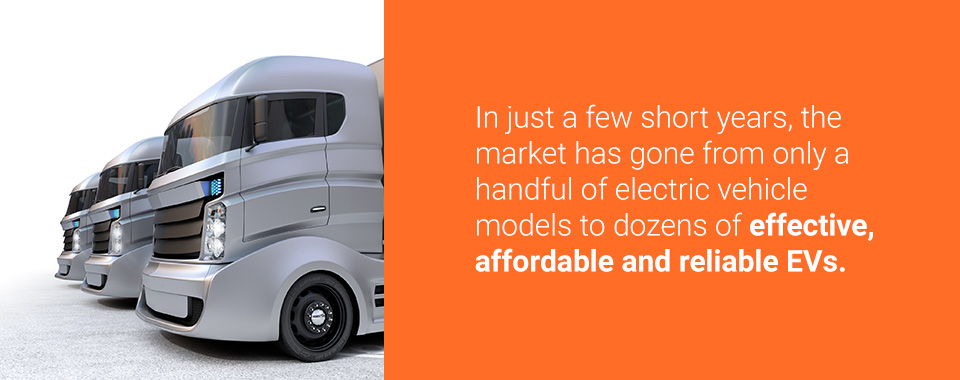
Some of the most well-known brands include Tesla, Volvo, Ford and Chevrolet, all of which are tirelessly developing new fleet vehicles that are high-performing and designed with businesses and productivity in mind. No matter the type of fleet vehicle you need, there is likely a suitable electric vehicle option available. From compact cars for local couriers to cargo delivery vans to electric semi-trucks, businesses of any category have options.
The key for businesses today is choosing the right kind of vehicle for their needs. This means finding vehicles with the suitable range and charging capabilities, and the cycle duty, size, cargo space and even towing capacity.
One of the main deterrents for consumers and businesses alike from switching to EVs is the perceived lack of charging infrastructure. Many people believe that electric vehicle charging is slow, inefficient and inconvenient, with limited access to power when needed. This was a fair criticism until recently. As charging stations become more widely installed around the country every month, fleet managers can rest assured that the charging infrastructure will only continue to expand and improve.
Additionally, the continued adoption of commercial electric vehicles will help to bring down the cost of installing charging infrastructure at all levels. Currently, fleet owners can expect to pay between $600 and $12,700 per charging station for a level 2 EVSE and $4,000 to $51,000 for the installation of a level 3 DCFC station. Though charging stations are an added investment, they eventually yield an unlimited return in reduced expenses, as well as time savings and improved productivity. With a smart EVSE implementation plan, fleet owners can find a cost-effective charging solution that’s both efficient and productive.
One of the most appealing reasons to transition your fleet to an electric one is the upgrade in vehicle performance and efficiency your fleet will immediately realize. If you’ve ever driven an electric vehicle, you will have no doubt noticed the instant improvement in power over a traditional combustible engine. Electric vehicles have superior torque, giving them power capabilities that are ideal for fleets in transportation, logistics and trucking.
Traditionally, logistics fleets have relied on diesel engines for their power needs. Today, electric vehicles provide unmatched torque ratings that surpass those of diesel trucks. If your fleets haul freight or even light cargo, making the switch the EVs could give your drivers a noticeable improvement in their driving capabilities as well as general performance and productivity out of the vehicle. Because of the superior efficiency of electric vehicles in getting up to speed, they also produce energy savings compared to traditional trucks.
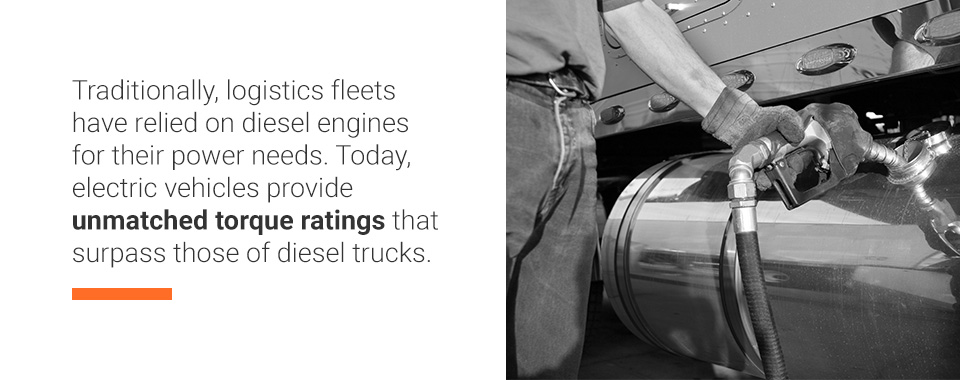
One of the clearest reasons for anyone to switch to electric vehicles is the immediate savings in fueling. Though electricity costs are rising in parity with other costs of living, overall electricity expenditures are much lower than gasoline and diesel costs. Electric vehicles operate at highly efficient levels.
Electric-drive components don’t require nearly as much energy input to operate effectively compared to internal combustion engines. As the size of the internal combustion engine increases, its components require more fuel consumption. With electric vehicles, the power consumption doesn’t require nearly the same scale. Still, it does consume more power as more performance is demanded of it in load capacity.
If one of the primary reasons you’re considering switching to an EV fleet is because of better financial control, remember to factor in the potential savings in insurance costs. Green fleet discounts are becoming more readily available among insurance brokers. Normally, insurance rates depend on the track record of the driving behavior. While this is still the primary metric brokers use when setting insurance rates, some companies are rewarding the switch to electric vehicles.
Green car discounts can help fleet owners offset the potential higher costs involved in insuring new electric vehicles. Because electric vehicles are typically appraised at a higher value, and their repairs are costlier, some insurance companies increase their rates to cover the higher insured value and associated risk. However, new electric vehicles also see far fewer breakdowns, mechanical malfunctions and parts wear. Shopping around for the best deal on electric vehicle car insurance and going with brokers that encourage EV usage can help businesses save on their TCO on EV fleets.
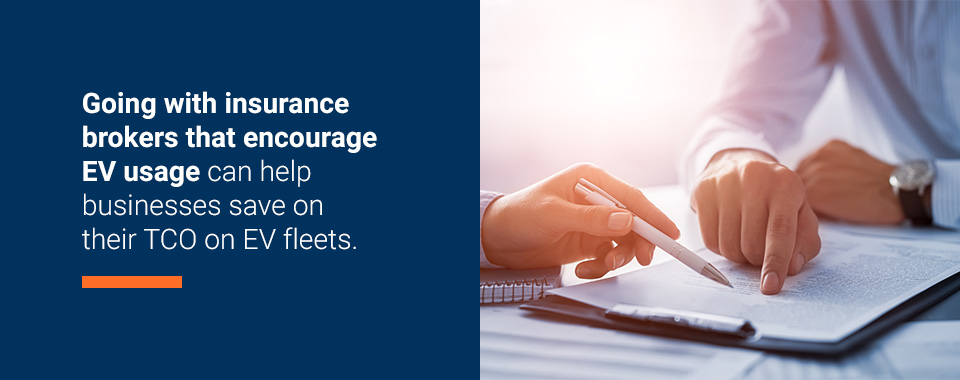
One of the added benefits of owning an EV fleet is the reduced maintenance needs. Fleet maintenance is a major aspect of managing a fleet of vehicles. It’s a time-consuming endeavor that’s vital for ensuring high productivity and profitability. Combustible engines are much more complex, with many more parts prone to wear and eventual mechanical failure. Staying on top of ongoing fleet maintenance is critical to preventing unexpected breakdowns.
With EV fleets, the maintenance responsibilities are far less. Managers avoid many of the common and ongoing preventive maintenance expenses, like oil and filter changes, transmission flushes and more. EVs don’t have any of these same parts, meaning these ongoing costs are eliminated. Instead, EV maintenance relies on very simple practices, like maintaining brake fluid and coolant levels. With an EV fleet, you’ll also see the need for fewer brake pad replacements. EVs are built with regenerative braking power, so there’s less wear on the parts.
With a green fleet, you’ll save on parts and labor as well as the time it takes to schedule servicing appointments. You’ll have less downtime, which is also a major concern in fleet management.
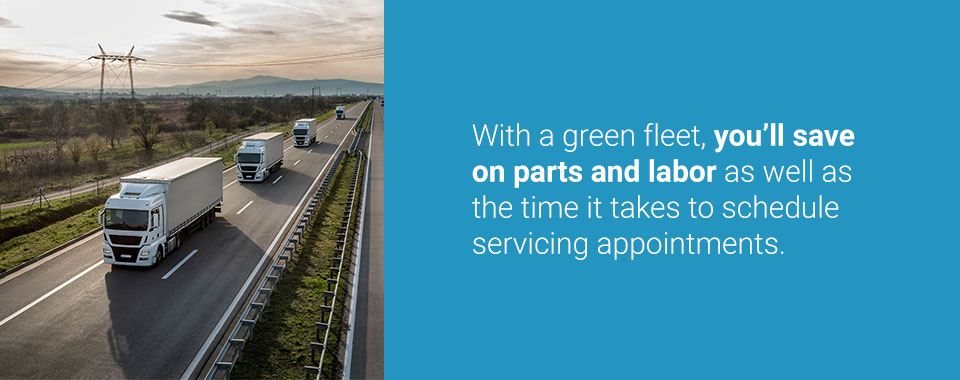
Another reason for switching to EVs that matters to a growing number of businesses today is the reduced environmental impact your fleet will produce. Since transportation accounts for 70% of petroleum consumption in the United States, switching to EVs can help reduce the national reliance on carbon fuels.
Not only does having a focus on greener operations improve the bottom line, but it also positions brands to be more competitive in an increasingly consumer-savvy market. Customers seek out companies that are making more sustainable business decisions, and workers also look for employers that are more environmentally responsible. EV fleets are another way to expand your company’s market share and attract and retain top talent.
Making the switch to an EV fleet is a smart financial and environmental move for businesses. To make the transition successful, managers need the best tools at their disposal to ensure high productivity and performance from their electric fleet vehicles. GPS technology provides managers with the EV fleet vehicle tracking data they need to make informed fleet deployment and planning decisions.
For all your green fleet vehicle tracking needs, choose Track Your Truck. Our end-to-end solutions provide fleet managers with the customized solutions they need to manage and optimize their EV fleets. With Track Your Truck services, you’ll be able to track your EV in real-time, record driving behavior and be alerted to driver habits that impact fleet performance. With a comprehensive reports feature, fleet managers will have the critical data at their disposal to ensure that their EV fleets are deployed intelligently and efficiently.
For more information on how Track Your Truck can help with your EV fleet transition, request a quote today.